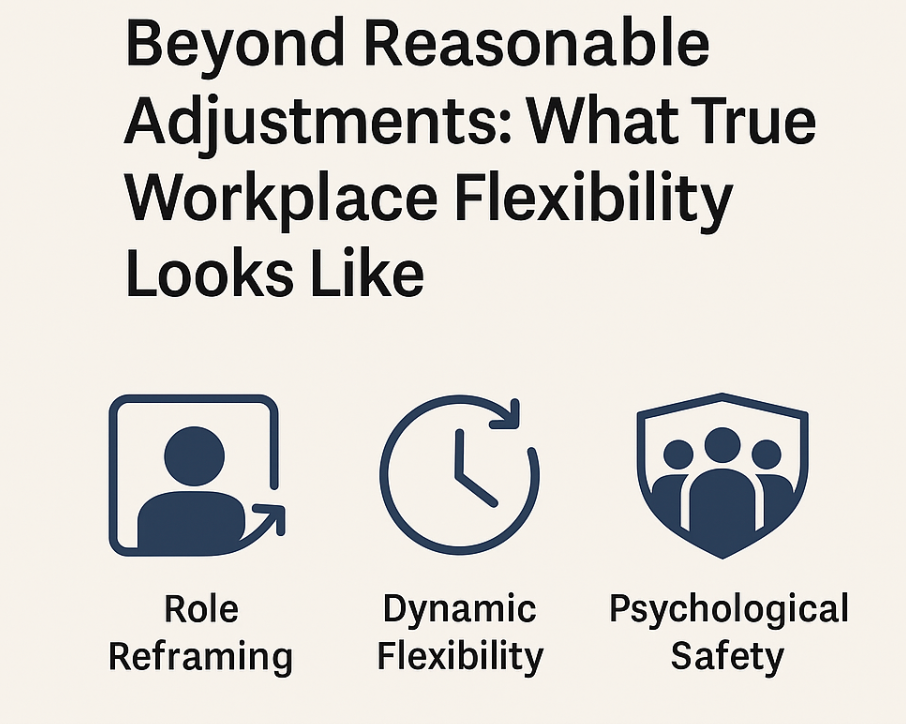Beyond Reasonable Adjustments: What True Workplace Flexibility Looks Like
- Elevation Occ Psy

- Jul 30
- 2 min read
When someone at work discloses a cancer diagnosis, the common organisational response is: “We’ll make reasonable adjustments.”
It sounds reassuring, but is it enough?
Reasonable adjustments are the bare minimum required by law in many regions. They typically include measures like modified schedules, time off for treatment, or ergonomic changes. These are important, yes, but they’re also reactive, compliance-driven, and often transactional.
The truth is, reasonable adjustments don’t guarantee psychological safety, meaningful work, or true flexibility, and these are the very things that matter most when navigating a serious illness.

The Problem with the Compliance Mindset
When organisations treat flexibility as a checklist, they risk overlooking the deeper needs of employees managing cancer:
Autonomy: The ability to shape how, when, and where work gets done.
Relatedness: Staying connected to the team without feeling like a burden.
Competence: Continuing to contribute meaningfully, even if capacity changes.
These needs aren’t abstract, they come straight from Self-Determination Theory (Deci & Ryan, 2000), which shows that when autonomy, competence, and relatedness are supported, people are more engaged, resilient, and satisfied.
For employees living with cancer, a compliance-only approach often translates to rigidity and stigma. “Flexibility” becomes permission to leave early on treatment days, not an ongoing dialogue about how to thrive in a new reality.
What Does True Flexibility Look Like?
True workplace flexibility is proactive, personalised, and rooted in trust. It moves beyond one-off accommodations toward job design that fits changing human needs.
Here’s what it looks like in practice:
1. Role Reframing, Not Just Schedule Tweaks
Instead of simply reducing hours, explore task redesign:
Which responsibilities energise the person?
What can be delegated or automated without stripping their sense of value?
This aligns with the Job Demands-Resources (JD-R) model, which highlights how reducing demands and boosting resources can sustain engagement during adversity.
2. Dynamic Flexibility
Illness isn’t linear. Energy and health fluctuate. True flexibility adapts in real time, through open communication and agile policies, not rigid agreements that require renegotiation at every bump.
3. Psychological Safety
Flexibility fails when employees fear career consequences. Leaders must normalise these conversations and reward transparency with support, not penalties.
4. Tech-Enabled Inclusivity
Hybrid and remote work options aren’t “nice-to-have” for employees with cancer, they are lifelines. Technology can bridge gaps, maintain collaboration, and reduce fatigue from commutes.
Why This Matters for Everyone
Cancer isn’t rare. 1 in 2 people will face it in their lifetime. Many will work through treatment or return afterward. Designing for these realities isn’t a niche effort, it’s future-proofing your culture.
And here’s the kicker: What supports employees with cancer, flexibility, trust, autonomy, benefits everyone. These principles drive retention, engagement, and performance across the board.
From Compliance to Compassionate Design
Reasonable adjustments keep organisations out of legal trouble. But true flexibility? That transforms workplaces into human-centered ecosystems, where people aren’t just accommodated, they’re empowered.
The question for leaders isn’t “What’s legally required?” It’s: “What would it look like to design work so people can thrive, even when life gets hard?”
💬 Your Turn: What does real flexibility look like in your organisation? Is it policy, or culture?




Comments